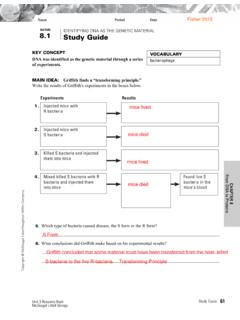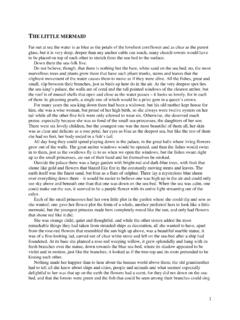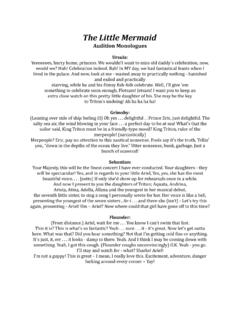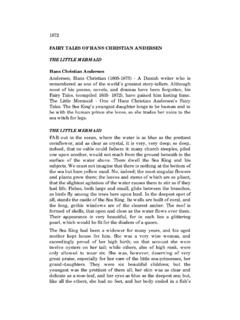Transcription of The Little Mermaid - Council Rock School District
1 The Little MermaidIcon and DisneyficationFinn Hauberg MortensenUniversity of CopenhagenAs AN ICON IN MASS , thc Little Meniiaid has becomethe official image of Denmark in general., and of its capital,t Copenhagen, in particular. Its icoiiicity is intimately tied to twosources: Edvard Eriksen's famous bronze statue erected on the Copen-hagen waterfront in 191? and Hans Christian Andersen's fairytale fromi8 7. The complexity of Andersen's fairytale, however, which lends thesymbolic value to Eriksen's statue, has been largely ignored becausethe statue has taken on a lite of its own. Historically, it belongs to thefinal phase of Danish classical sculpture., but it has also become theraw material of modernistic artistic expressions. In fact over the lastfort^' years, the statue has moved toward two distinct representations:the completed statue by Eriksen viewed and re\ered by die millions oftourists who visit and photograph it and the ongoing fragmented andunfinished work, which has derived from the destruction of the latter ''work of art" in turn points to the modernit)' of which itand Denmark has become fragmentation started in i fti, when the statue had its hair paintedred and was dressed up in a bra and panties.
2 Two years later she waspainted red again. In 1964, these prankish attacks were followed by anact of willful artistic vandalism when an unknown assailant sawed thehead off the body. Later, J rgen Nash, a situationist visual artist andauthor, claimed responsibility for removing the head and for making adeliberate assault on die Danish national symbol. Again, in the 1970sand 'Sos, the nadonal symbol came under attack. In 1990, she lost halfof her head, and in 1998, the entire head was again severed from herbody. The final attack to date took place in 2003, when the mermaid438 SCANDINAVIAN STUDIESwas blown off her stone, thrown into die water with injured kneesand lips. After reconstructive surgery, she was placed back at "home"on her stone. Since 2008, the daily newspaper Politiken has offered a"Genetically Modified Mermaid " to its readers.
3 It is a small porcelaincopy of a large sculpture made by the great Danish sculptor BjornNorgaard. In the comfort of their living rooms., the Danes can enjoyin miniature what can be seen in its original size in the Copenhagenharbor: a monstrosity intended by Norgaard to function as a com-mentary on Eriksen's statue. Norgaard's Mermaid ., with deep cuts intoher hips, has been "genetically modified" in a biotech laboratory. Thepoint is that so-called deconstructed and wounded nature has becomea part of culture, not because it has been brought into the living roomsas a knick-knack, but because it is a continual modification of previouscultural representations. The article focuses on Andersen's fairytaleThe Little MermaidLITTLE Mermaid 439and shows how the Mermaid in the text can be seen as an icon, a saint-like representation, whose existence is articulated as witli her statuarylife in water, on land, and in the CULTURE AND MASS CULTUREOn its way to the sea, the Odense River still nuis sluggishly throughthe city.
4 The riverbed is not deep. Here in the eold water, Andersen'smother stood and washed dothes for the well-to-do. In 1855, he depictedthis scene in "Hun ducde ikke" ["She was Good for Nothing"], whichtells of a mother with a heart of gold who dies from the cold and }' years earlier, he placed the setting of another of liis fairytales," Little Claus and Big Claus," by the same river. Little Claus the sharpand cunning proletarian settles accounts with the powers that be ;mdfinally fools Big Claus such tliat he is drowned, in having been temptedby the fine sea cattle that are at the botrom of the river. Sea cattle belongin later Nordic folklore to the merpeople and were therefore associatedwith mermen and sea giants, who were believed to be the cause ofaccidents at sea a magical element that was respected for the sake offertilit}', Nordic folklore also describes bipartite bodies that were halfwoman and half fish.
5 They are first mentioned in medie\ al folk balladsand later become part of the fabric of the legends of feudal traditionalculture in which they were most often depicted as the friendly helpersof 's "Den Hlle Havfrue" [The Litde Mermaid ] was writtenin 1836-37 and first published on April 7, 1837. Although the authormaintained that his work had no model, the tale nonetheless drawson the traditions ofan older feudal oral folk culture. Folk ballads hadearlier supplied Danish authors such as Johannes Evald with aspectsof the Mermaid theme, and Andersen himself had already utilized thetopic as, for example, in "Agnete og Havmanden" ["Agnete and theMerman"] from 1833 in which the merman states that Agnete can onlyobtain an immortal soul through her love, "Den lille Ha\' " is alsoinspired by works of Andersen's contemporaries.
6 Part of the plot is bor-rowed from Ingemann's De nderjordiske [The Creatures from dieUnderworld] (1817) while the Mermaid 's longing for an immortal souland the transformation of her body intt> sea foam derives from a shorrnarrative entitled Undine {i8ii) by the German author Friedrich de la44-0 SCANDINAVIAN STUDIESM otte Fouquc. Andersen's text, thus., contributes to the comprehensivereconstitution aiid remediation of tlic traditional culture of die complicated network unfolds in connection with the , for example, draws on several different sources, and manyother contemporary works on mermaids from his age that may havealso sen'ed as a basis for the reconstitution and remediation of thisfigure by mass culture in more recent times. Such problems, tliough,are beyond the scope of this article.}
7 , the premise of which is that thisfair\tale in particular exhibits equalities that changed the course of tradi-tion and supplied modern industrial, popular, and mass culture withmaterial. A more detailed discussion of these propositions will not bepossible here, however, since I wish to concentrate instead on an analy-sis of die text and its remediation by Walt Disney, who has famouslydrawn on Andersen's fair\tale and delivered it to movie theaters andVCR'S in even the remotest parts of the globe. Although its meaningand understanding presuppose the original tale, it appears only in theform of reconstructions and repetitions remediations that both giveit meaning while taking it Disney film presents not only tlie text, but also the sailpturepurchased in 1913 by the founder of Carlsberg Brewery, Carl Jacobscn,and placed at Langelinje in Copenhagen.
8 The artist, Edvard Eriksen,rather innocendy depicted the dancer Ellen Price on a maritime baseand placed the figure on a flat stone near the pier. Eriksen was inspiredby the French sculptor Henri Ch pu^s Jeanne d'Arc (1870), a replica ofwhich was displayed in Copenhagen. Eriksen's Mermaid is not simplya sculpture. At a diminutive height of meters, it is a national iconundoubtedly associated with Andersen, but at the same time, it hasbecome disassociated from the author and independently stands todayboth as a symbol of Denmark in genend and of Copenliagen in as well serves as the springboard tor remediadons that are only remotelylinked to Andersen although they play a significant role in today's folkculture, the tourist and culture industrj'. Wliile Eriksen's mermaidlongs wistfully or tragically for a love that cannot be realized, a steadystream of postcards and merchandise generally manages to portray heras Little more diaii a reference to die first countrj' to lift the criminalban on pornographic pictures in 1969 or to the world-famous blondsin Wonderftd Copenhi^ MERMAIDOne frequently sees examples of advertisements, pictures in the press,iuid newspaper articles that ascribe a sexual motive or activity' to themermaid that are altogether foreign to the works of both Andersen andEriksen.
9 One such example is the large b lll'K)ard advertisements thatwere displayed throughout Rome a few years ago depicting a mermaidwhose genital region was merged with half a banana whose peei wasslit slightly upwards at the hmom. Evidently, tliis combination of onemale and one female sexual attribute was intended to sell more bananayogurt. Two other stories in the Danish newspapers the day the reporton this advertizing campaign was published also come to mind.' The rst reports on the gay pride parade, "Danish Mermaid Pride,'' w liichwas criticized on the streets for its march through Copenhagen by alesbian group arguing tliat homosexual i tA' should not be portrayed assomething unique. Thc seajnd is from Wecki Wachee, Florida, a waterpark that has fidlen on hard times despite the fact that generations ofyoung girls once fought to appear there dressed in a Mermaid costumeand submerged in a gigantic glass tank before half a million visitorseach year.
10 The job is tough since the girls are not only supposed toswim convincingly and with a smile as they flit about in the cold waterwith their Lycra tails, but also must be able to get oxygen from timeto time from underwater breathing hoses designed for that must also contend with thc stray sea animals that occasioiiall)' findtheir way into the tank From the [(x:al river. Given a choice, the girlslike the peaceful sea cows the best because they love to be scrubbed onthe back while die tank is being cleaned. The pay for this job staits at$ an hour, and the entire set-up is managed by none otlier than theinimitable Ms. 1964, another and more sophisticated meaning was attributed tothe statue. Paradoxically, its status was underscored after it was defacedby a steady array of unknown vandals who sawed off the Mermaid 's headand carried it off.]



















